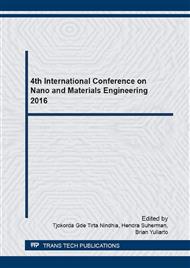[1]
S.D. Genieva, S.C. Turmanova, A.S. Dimitrova, and L.T. Vlaev, Characterization of Rice Husks and the Products of Its Thermal Degradation in Air or Nitrogen Atmosphere, Journal of Thermal Analysis and Calorimetry, Vol. 93 (2008) 2, 387-396.
DOI: 10.1007/s10973-007-8429-5
Google Scholar
[2]
Y. Nakata, M. Suzuki, T. Okutani, M. Kikuchi and T. Akiyama, Preparation and Properties of SiO2 from Rice Hulls, Journal of the Ceramic Society of Japan, International Edition Vol. 97, 1989, pp.830-836.
DOI: 10.2109/jcersj.97.842
Google Scholar
[3]
Food and Agriculture Organizations of the United Nations, FAO STATISTICAL YEARBOOK 2013 World Food and Agriculture, Food and Agriculture Organization of the United Nations, ISBN 978-92-5-107396-4, Rome (2013).
DOI: 10.18356/be4d2f4a-en
Google Scholar
[4]
Bureau of Agricultural Statistics (BAS), Crop Statistics of the Philippines 2008-2012 (National and Regional), Department of Agriculture, ISSN-2012-0487, August (2013).
Google Scholar
[5]
E.S. Mirasol, R.B. Cervera, Production of Amorphous and Crystalline Silica from Philippine Waste Rice Hull, Advanced Materials Research. 1098 (2015) 80-85.
DOI: 10.4028/www.scientific.net/amr.1098.80
Google Scholar
[6]
R. Yuvakkumar, V. Elango, V. Rajendran, and N. Kannan, High-purity nano silica powder from rice husk using a simple chemical method, Journal of Experimental Nanoscience, DOI: 10. 1080/17458080. 2012. 656709.
DOI: 10.1080/17458080.2012.656709
Google Scholar
[7]
A. Onojah, A.N. Amah, and I.M. Echi, Polymorphs of Crystalline Silica from Rice Husk, Journal of Basic Physical Research Vol. 3, pp.73-75, June, (2012).
Google Scholar
[8]
E.S. Mirasol, and R.B.M. Cervera, Production of Amorphous and Crystalline Silica from Philippine Waste Rice Hull, Advanced Materials Research Vol. 1098, 2015, pp.80-85.
DOI: 10.4028/www.scientific.net/amr.1098.80
Google Scholar
[9]
A. Chakraverty, P. Mishra, and H.D. Banerjee, Investigation of combustion of raw and acid-leached rice husk for production of pure amorphous white silica, Journal of Materials Science 23 (1988) 21-24.
DOI: 10.1007/bf01174029
Google Scholar
[10]
T. Okutani, Silica in Rice Hulls as Raw Materials for Silicon Semiconductors, Journal of Metals, Materials and Minerals, Vol. 19 No. 2, 2009, pp.51-59.
Google Scholar
[11]
D.S. Jung, M.H. Ryou, Y.J. Sung, S.B. Park, and J.W. Choi, Recycling rice husks for high-capacity lithium battery anodes, edited by S.J. Harris, PNAS, Vol. 110 no. 30, 2013, p.12229–12234.
DOI: 10.1073/pnas.1305025110
Google Scholar
[12]
C.P. Garrido, R.B. Cervera, Synthesis of Amorphous Fe-doped SiO2 Anode Nanomaterial via Sol-gel Method, Advanced Materials Research. 1119 (2015) 38-42.
DOI: 10.4028/www.scientific.net/amr.1119.38
Google Scholar
[13]
U. Kalapathy, A. Proctor, and J. Shultz, A simple method for production of pure silica from rice hull ash, Bioresource Technology 73, 2000, pp.257-262.
DOI: 10.1016/s0960-8524(99)00127-3
Google Scholar
[14]
S.H. Javed, S. Naveed, N. Feroze, M. Zafar, and M. Shafaq, Crystal and Amorphous Silica from KMnO4 Treated and Untreated Rice Husk, Journal of Quality and Technology Management Volume VI, Issue 1, June, 2010, pg. 81 – 90.
Google Scholar
[15]
P. Lv, H. Zhao, J. Wang, X. Liu, T. Zhang, and Q. Xia, Facile preparation and electrochemical properties of amorphous SiO2/C composite as an anode material for lithium ion batteries (Short Communication), Journal of Power Sources 237, 2013, 291-294.
DOI: 10.1016/j.jpowsour.2013.03.054
Google Scholar


